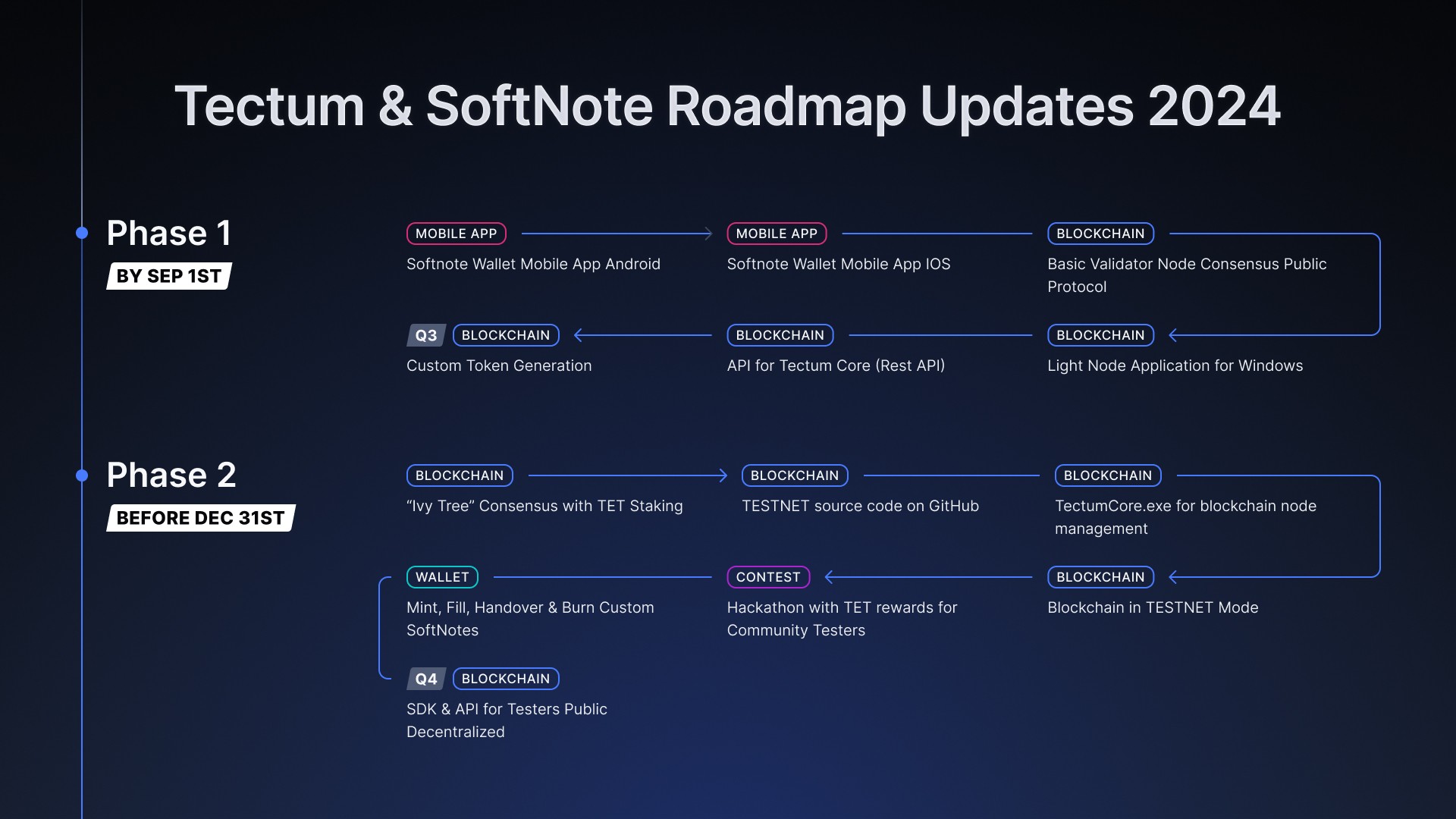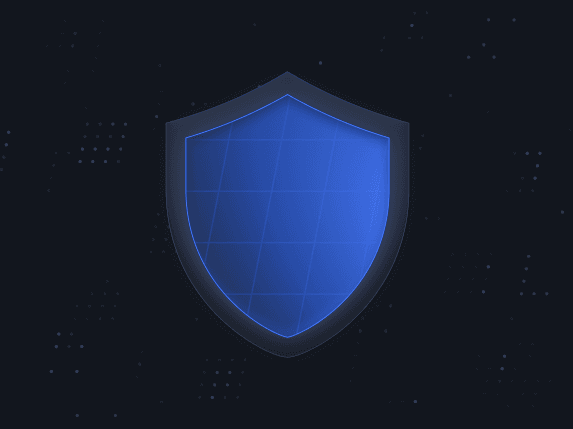Tectum Roadmap Update Phase One: Launching Products in Live Mode
As part of Phase One of our roadmap update, Tectum will launch several products in Live Mode by September 1, 2024. These will include:
- SoftNote Wallet Mobile Apps for Android and iOS
- Basic Validator Node Consensus Public Protocol
- Light Node App for Windows
- Tectum Core UX/UI for Light Nodes
- API for Custom UX to Light Nodes
- Custom Token Generation
- Private Blockchain with Distributed Ledger
- Tectum Explorer Source Code
These releases will be available for immediate use by the community.
SoftNote Mobile App for Android and iOS Devices
Tectum is thrilled to advance its flagship product, SoftNote, towards mass adoption with the imminent release of the SoftNote Mobile Wallet on Android and iOS.
The team has meticulously refined the wallet’s functionalities and streamlined the UI to ensure robust performance and a seamless user experience, now nearing the final stages of development for the app, which will be delivered in the first development phase.
The mobile application will encompass all features available on the web version, with ongoing updates to the website seamlessly integrated into the mobile app on both platforms. Moreover, these products will launch in Live Mode, enabling community members to use them immediately upon release.
This marks an important milestone in the payments revolution driven by SoftNote technology, making it easier for both users and merchants to adopt and utilize our revolutionary technology.
Private Blockchain and Distributed Ledger in Tectum Roadmap Update
On a similar note, Tectum will achieve another significant milestone with the launch of its private blockchain and decentralized ledger, incorporating the basic validator node consensus protocol.
Additionally, developer-centric enhancements will be underway, featuring an API that will facilitate seamless integration of Light Nodes with the private blockchain. This API will also provide access to the SoftNote Wallet via standard login methods, enabling developers to execute operations such as minting, burning, blacklisting, sending, and transferring ownership of custom tokens.
Transactions conducted through Light Nodes will involve a minimal fee of 0.1% of the transaction value, capped at $1, contingent upon joint approval from Validator Nodes and the originating Light Node. These advancements will underscore Tectum’s commitment to advancing blockchain technology and enhancing user accessibility and functionality across its platform.
Understanding Tectum’s Light Node
To clarify the concept of “Light Node,” it plays a crucial role within Tectum’s ecosystem. While those well-versed in blockchain technology may grasp its fundamental functions, Tectum’s Light Node serves a specific and essential purpose.
Operating as a vital component of the broader Tectum public network, the Light Node empowers developers to create custom applications on our blockchain. Essential for achieving a fully decentralized network, Light Nodes prioritize efficiency and user-friendliness in supporting network participation and validating transactions.
Developers leveraging Light Nodes can seamlessly integrate their independent projects with the Tectum blockchain. These nodes connect to full validator nodes to validate data transfers and contribute new blocks to the chain. Therefore, transactions through Light Nodes require validation from at least one validator node.
The launch of Light Nodes aims to ensure the network’s resilience and its capability to support customized development, preparing for the upcoming public blockchain testnet.
API for Tectum Core & Custom Token Generation
In the upcoming update, developers will discover compelling new features. They will gain access to a dedicated API designed to integrate their own user experiences (UX) into LightNodes. This API will offer extensive functionality, empowering developers to create tokens and diverse decentralized applications (dApps). It will present developers with a system akin to the Ethereum network but with remarkable enhancements in speed, efficiency, and overall performance.
Furthermore, developers will have the capability to generate and manage custom tokens using both public and private key pairs. These custom tokens will support functionalities such as minting, defining decimals, setting initial supply and hard caps, burning tokens, blacklisting addresses, sending tokens, pausing transactions, and transferring ownership. Additionally, developers will have the freedom to build their own explorers using the source code of the original Tectum Explorer provided by the Tectum team.
Transactions initiated by developers through LightNodes will require validation from at least one Validator Node and the originating Light Node. The Validator Node will confirm and append the transaction to the blockchain before it becomes visible on the existing Tectum Explorer. This robust infrastructure ensures security and reliability across the platform, reinforcing Tectum’s commitment to advancing blockchain technology.
Tectum Roadmap Update Phase Two: TestNet Release & Hackathon
Phase Two of our roadmap will mark a significant milestone for our community—the launch of the Testnet. This phase will open doors for interested developers to rigorously test the fastest network available on the market, offering a compelling opportunity for involvement and integrating valuable community input. Additional highlights of this phase will include the release of advanced consensus mechanisms, community hackathons with TET rewards, and the introduction of essential tools such as TectumCore.exe and SDK/API for testers.
Public Blockchain Launch in TestNet Mode
Following the successful launch of the private blockchain in Live Mode, Tectum will proceed to release the public decentralized blockchain in Testnet Mode. This phase will enable community members to actively participate in testing and refining our network.
The exact timeline for the live release of the Tectum public blockchain will remain fluid, contingent upon the completion of thorough testing. During this phase, developers will engage in a Hackathon dedicated to exploring and providing insights into the Tectum public blockchain. A compensation plan will be devised for participants, ensuring everyone contributing to the testing effort receives $TET.
The full source code of the TestNet version of the public blockchain will be made publicly available on GitHub, offering comprehensive information to interested participants. Additionally, developers will gain access to the SDK and API when the public testing version goes live. The TectumCore.exe application will also be provided, facilitating developers in effectively managing the TestNet blockchain node.
As the public blockchain is launched in test mode, developers will have the capability to generate and manage custom tokens using both pairs of keys. They will be able to mint and govern custom tokens on the public network, alongside the ability to mint, fill, burn, and transfer custom SoftNote Bills.
Willow Tree Consensus for TET Staking Weight Ceiling
The Willow Tree Consensus for $TET staking will introduce a revolutionary Weight Rating Ceiling, distinguishing itself from traditional models. This approach ensures fair reward distribution by considering factors like staked tokens, computing power, utility points, and electricity usage.
In most staking systems, rewards are solely based on token quantity, which favors those with more tokens. Tectum’s Willow Tree Consensus, however, will use multiple factors to reward $TET validators.
The system calculates a maximum Weight Ceiling based on staked Tectum Tokens, determining potential rewards. For instance, staking 100,000 tokens might yield a ceiling of 100, while staking 20,000 tokens could result in a ceiling of 20. Actual rewards will also depend on factors like the computing power used for transaction validation.
These features will initially be accessible in Testnet mode and not yet available for public use
Tectum Roadmap Update: Tackling Key Challenges Ahead
Some might be wondering what Tectum intends to achieve with this roadmap update. After all, we already have an excellent ecosystem comprising exquisite products and partners. So, what are we improving on?
These points below will properly answer the question above:
- Decentralization: The first and obvious reason is decentralization, which is possible through the private blockchain’s distributed ledger and the public blockchain. In previous articles, we always talk about Tectum solving the blockchain trilemma and this has always been our goal. With security and scalability no longer an issue, we are working on distributing control from a central point of authority. Distributing operations among shareholders will encourage more participation in the network.
- Security and Redundancy: This is where things may get confusing, especially since we previously stated that security is no longer an issue. In reality, decentralization itself is another form of security. A decentralized network is less prone to redundancy and single points of failure. Tectum provides an opportunity for individuals and corporations to become validators. This ensures that attacking one node will not cause the entire network to stop functioning. Moreover, these new measures will not negatively impact the existing safety measures within our blockchain.
- Developers Access and More Use Cases: As the fastest layer-1 blockchain with a speed of 3.5 million transactions per second, it will be a shame that Tectum only limits use cases to applications we develop in-house. Especially when you consider that there are no wholesome blockchain solution with as much possibilities as ours. In this regard, the team is launching a public blockchain that will enable developers build dApps just like on the Ethreum Network.









